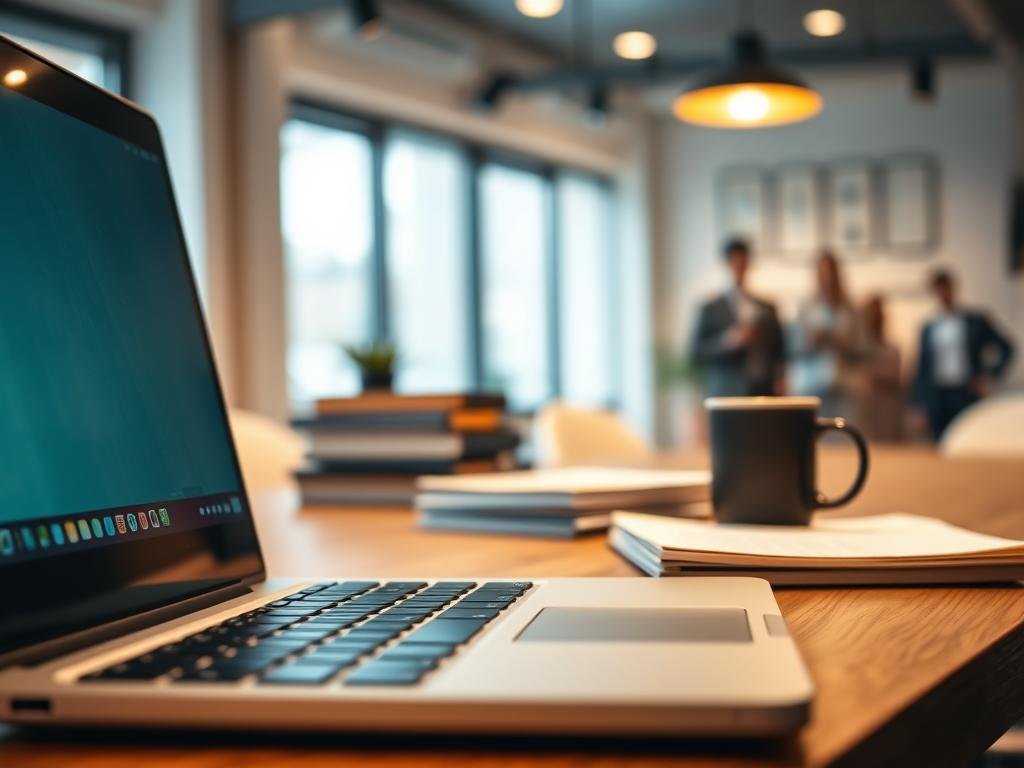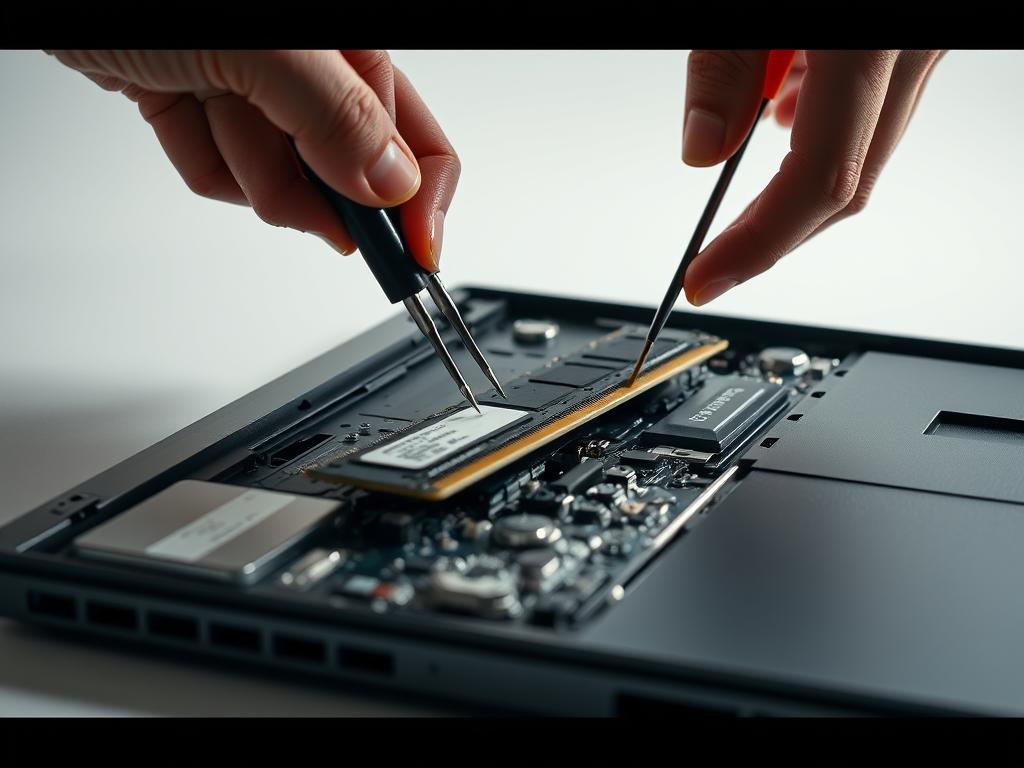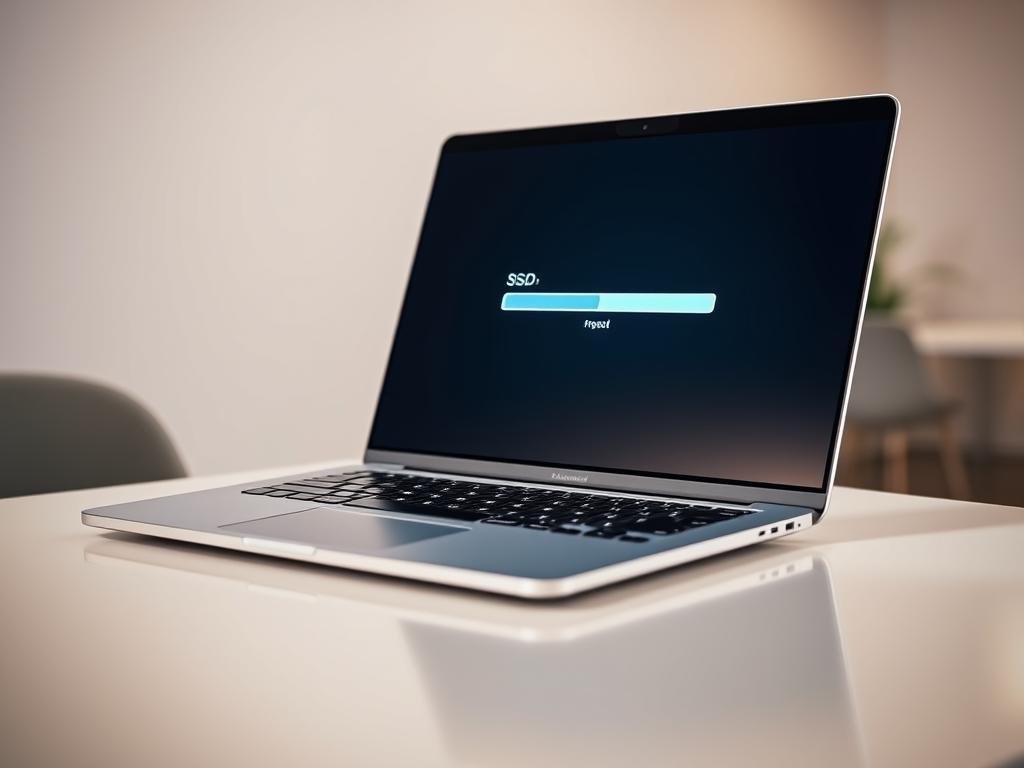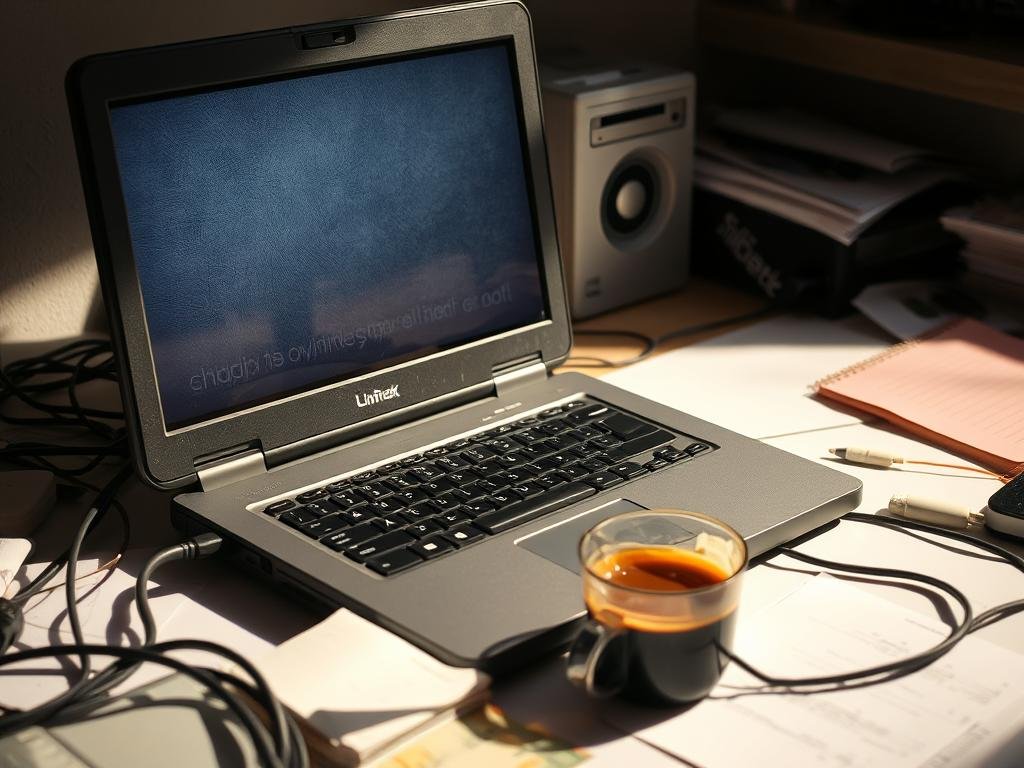Are you tired of your laptop running slow? You’re not alone. A study found that many users see their laptop’s speed drop over time. A slow laptop can really slow you down, whether you’re working on a project or making a video call.
But, there’s hope. You can speed up your device without getting a new one. Simple steps can make your old PC run like new again. For example, cleaning up temporary files, removing unused startup programs, and tweaking visual settings can all help.
Key Takeaways
- Restarting your device regularly can help clear temporary files and shut down background programs.
- Checking hard drive storage and freeing up space can improve performance.
- Scanning for malware and viruses is essential for maintaining speed and performance.
- Closing unnecessary browser windows and background programs can speed up your device.
- Upgrading your RAM can significantly enhance your laptop’s performance.
Common Reasons Your Laptop is Slow
A slow laptop can be really frustrating. But knowing why it happens can help fix it. Many things can make your laptop run slower.
Insufficient RAM
Not having enough RAM is a big reason for a slow laptop. RAM is where your laptop stores data temporarily. If you have too many apps open, it can’t handle it, making things slow. Getting more RAM can make your laptop much faster.
Outdated Hardware
Outdated hardware is another big problem. New software needs more powerful hardware to run well. If your laptop’s hardware is old, it can’t handle new programs, slowing it down.
Background Processes
Background processes can also slow your laptop. Many apps run in the background, using up resources. Finding and stopping apps you don’t need can help your laptop run better.
To make your laptop faster, you need to find out why it’s slow. Here are some common problems:
- Not enough RAM or old hardware
- Too many apps running in the background
- Malware or viruses
- Not enough disk space because of too many files or apps
By fixing these issues, you can make your laptop run much faster. You’ll enjoy using it again without frustration.
Check for Software Updates
One of the simplest ways to boost your laptop’s speed is by updating software. Regular updates can fix bugs, boost security, and make your system more efficient.
Operating System Update
Keeping your operating system up to date is key for speed and security. To update Windows, go to Start > Settings > Windows Update and click Check for updates. This keeps your system safe and running smoothly.
Driver Updates
Old drivers can slow down your laptop. To update drivers, use the Device Manager. Right-click on the Start button and select Device Manager. Expand categories, right-click on devices, and choose Update driver. For more on why your computer might be slow, check CNET’s article on computer performance.
Application Updates
It’s also important to keep your apps updated for the best performance. Most apps can be updated through their settings menus. For example, many Windows apps can be updated via the Microsoft Store by going to Library > Get updates.
| Update Type | Description | Steps to Update |
|---|---|---|
| Operating System | Enhances security and fixes bugs | Start > Settings > Windows Update |
| Drivers | Improves hardware performance | Device Manager > Update driver |
| Applications | Fixes bugs and adds features | App Settings > Check for updates |
By regularly updating your software, you can make your laptop faster and more reliable. This is a key part of laptop optimization, keeping your device running well over time.
Optimize Startup Programs
One effective way to revive your slow laptop is by optimizing the programs that launch during startup. Too many programs running at startup can slow down your laptop’s boot time and performance.
Accessing Task Manager
To start managing startup programs, you need to access the Task Manager. Right-click on the Taskbar and select Task Manager from the dropdown menu. Or, press Ctrl + Shift + Esc to open it directly.
Once the Task Manager is open, navigate to the Startup tab. This tab lists all the programs that launch when your laptop starts up.

Disabling Unnecessary Apps
Review the list of startup programs carefully. Identify any applications you don’t need to launch at startup. Disabling unnecessary apps can help improve your laptop’s speed and reduce lag.
To disable a program, right-click on it and select Disable. Be cautious, as some programs are essential for your laptop’s functionality.
Managing Startup Impact
The Task Manager also shows the startup impact of each program. It categorizes them as High, Medium, or Low impact. Focus on disabling programs with a High startup impact to improve performance.
By managing your startup programs effectively, you can significantly improve your laptop’s performance. This reduces the time it takes for your laptop to become ready for use.
Clean Up Hard Drive Space
Cleaning your hard drive can make your laptop run faster. Over time, your laptop fills up with data. If it’s almost full, it slows down a lot.
To start, check how much storage you have left. You can do this by going to your laptop’s settings or using the file explorer. Once you know how much space you have, you can find ways to use less.
Uninstalling Unused Applications
One way to free up space is by uninstalling apps you don’t use. We often download many apps but never use them again. Getting rid of these apps can save a lot of space.
- Go to your laptop’s control panel or settings.
- Find the “Programs and Features” or “Apps” section.
- Identify applications you no longer need or use.
- Uninstall these applications to free up space.
Removing Temporary Files
Temporary files also take up a lot of space. These files are made by apps and the system but stay long after they’re needed.
To remove temporary files:
- Use the Disk Cleanup tool (more on this below).
- Manually delete temporary files by searching for “%temp%” in your start menu and deleting the contents of the Temp folder.
Utilizing Disk Cleanup Tools
Disk Cleanup tools are built into most operating systems. They help remove files you don’t need.
| Tool | Description | Benefits |
|---|---|---|
| Disk Cleanup | Removes temporary files, system files, and other unnecessary data. | Frees up disk space, improves performance. |
| Storage Sense | Automatically frees up space by deleting unnecessary files. | Convenient, automated maintenance. |
For more tips on improving your device’s performance, you might find it helpful to learn how to make your old phone run like, as many of the principles apply to laptops as well.
Check for Malware and Viruses
When your laptop is slow, it’s important to check for malware and viruses. These can slow down or crash your laptop. To fix this, run security scans, know the symptoms, and use good antivirus software.
Running Security Scans
To find malware and viruses, use your antivirus software for a scan. Here’s how:
- Go to Start > Settings > Update & Security > Windows Security.
- Click on Virus & threat protection.
- Select Scan options and choose your scan type.
- Click on Scan now to start.
Regular scans can find and remove malware and viruses. This improves your laptop’s speed.
Understanding Common Symptoms
Malware and viruses show up in many ways. Some signs include:
- Slow performance or freezing.
- Unexplained crashes or restarts.
- Pop-ups or unusual messages.
- Unfamiliar programs or icons on your desktop.
If you see these signs, run a scan to find and remove threats.
Using Reliable Antivirus Software
Good antivirus software is key to protect your laptop. Here’s how to choose and use it:
- Pick a well-known and trusted antivirus program.
- Keep your antivirus software updated.
- Run regular scans to find and remove threats.
By following these tips, you can lower the risk of malware and viruses slowing your laptop.
![]()
By checking for malware and viruses, running scans, knowing symptoms, and using good antivirus, you can fix laptop performance issues and slow laptop fix. Regular care keeps your laptop running well.
Upgrade Your RAM
Upgrading your laptop’s RAM is a simple way to make it faster. RAM is like a workspace for your laptop. It holds the files and apps you’re using. More RAM means your laptop can do more things at once without slowing down.
Identifying Compatibility
Before you upgrade, make sure the new RAM fits your laptop. Look in your laptop’s manual or on the manufacturer’s website. They’ll tell you what type of RAM you need (like DDR3 or DDR4) and how much.
Installing New RAM
Adding new RAM is easy. First, turn off your laptop and take out the battery. Then, find the RAM slots on the bottom. Take out the old RAM and put in the new ones, making sure they’re locked in place.

Benefits of Increased Memory
More RAM means better multitasking, faster app loading, and a smoother experience. You can have many apps open at once without your laptop slowing down.
| RAM Size | Basic Tasks | Multitasking | Heavy Applications |
|---|---|---|---|
| 4GB | Sufficient | Limited | Poor |
| 8GB | Good | Sufficient | Limited |
| 16GB or more | Excellent | Good | Sufficient |
Upgrading your RAM can really speed up your laptop. It makes your computer work better, whether you use it a lot or just a little. Having enough RAM means your laptop can handle your tasks well.
Consider an SSD Upgrade
To make your slow laptop faster, think about getting an SSD. SSDs use flash memory to access data quickly. This can make your laptop much faster and more efficient.
Reasons to Upgrade to an SSD
SSDs are faster and more reliable than traditional HDDs. They don’t have moving parts, so they’re less likely to break. A study found that SSDs can make your laptop start up in seconds. They also make apps launch much faster than HDDs.
Upgrading to an SSD has many benefits:
- Faster boot times
- Quicker application loading
- Enhanced overall system performance
- Lower power consumption
Installation Process
Installing an SSD is easy. You can swap out your old HDD or add the SSD as a second drive. If you’re replacing your HDD, you’ll need to copy your data to the new SSD or start fresh with your operating system.
If you’re not good with tech, it’s best to get help from a pro. This way, you avoid losing data or damaging your laptop.
Performance Boost
Getting an SSD will make your laptop feel like new. It loads documents, images, and videos fast. A tech expert said, “The difference is huge; apps start right away, and you can do many things at once without any lag.”
“Upgrading to an SSD is one of the best decisions you can make for your laptop’s performance.”

By switching to an SSD, you’ll cut down on laptop lag. You’ll enjoy a smoother and more efficient computing experience.
Adjust Visual Effects
Visual effects make your laptop look good but can slow it down. Changing them can help a lot.
Start by tweaking visual effects settings. This means adjusting animations and window transitions.
Reduced Motion Settings
First, turn off animations that use too much power. Here’s how:
- Go to Start > Settings > Ease of Access.
- Select Display and toggle the switch under Show animations in Windows to off.
Modifying Appearance Settings
Changing your laptop’s look can make it run smoother. Here’s how to do it:
- Right-click on the desktop and select Personalize.
- Under Themes, select Desktop icon settings and adjust as needed.
For more detailed changes, follow these steps:
To disable visual effects, go to Start > System > About and click Advanced system settings. Then, go to the Advanced tab, under Performance, click Settings, and select Adjust for best performance.
| Setting | Description | Impact on Performance |
|---|---|---|
| Animations | Controls window and menu animations | Disabling can improve responsiveness |
| Transparency Effects | Affects the transparency of windows and menus | Reducing or disabling can enhance performance |
| Visual Styles | Controls the overall visual appearance | Simplifying can reduce system load |
Manage Power Settings
Optimizing your laptop’s power settings can make it run faster. It’s a simple way to boost your laptop’s performance and efficiency.
Changing Power Options
To adjust your laptop’s power settings, start by opening the Power Settings menu. You can find it by searching for “Power Options” in the Start menu. Inside, you can pick from Balanced, Power saver, or High performance plans. Choosing High performance lets your laptop use more power for better performance.
Steps to Change Power Options:
- Open the Start menu and search for “Power Options.”
- Click on “Power Options” to open the Power Settings window.
- Choose a power plan that suits your needs.
Optimizing for Performance
To optimize your laptop’s performance, adjust its thermal settings. Tools like Dell Optimizer or Dell Power Manager can help. They manage your laptop’s performance and thermal settings efficiently.
Benefits of Optimizing Power Settings:
| Benefit | Description |
|---|---|
| Increased Performance | Optimizing power settings can lead to a significant increase in your laptop’s performance. |
| Better Thermal Management | Fine-tuning thermal settings helps in maintaining an optimal temperature, which enhances overall performance and longevity. |
| Enhanced Efficiency | By balancing power consumption and performance, you can achieve a more efficient operation of your laptop. |
Effective management of your laptop’s power settings can make your computing experience faster and more efficient.
Regular Maintenance Tips
To keep your laptop running smoothly, regular maintenance is key. A few simple tasks can boost your laptop’s speed. This way, you avoid slow laptop problems.
Scheduling Disk Cleanup
Regular disk cleanup removes unwanted files. Use the built-in Disk Cleanup tool in Windows to start. For more info, check the Microsoft support page.
Updating your Software
Keeping your OS and software updated is essential. Updates fix bugs and improve security.
Physically Cleaning Your Laptop
Dust can make your laptop overheat and slow down. Clean vents and fans often. Also, restart your laptop and tidy up your desktop and taskbar.
By following these tips, you can keep your laptop fast and efficient.
FAQ
Why is my laptop slow even after I’ve closed all the applications?
Your laptop might be slow because of background processes, not enough RAM, or old hardware. Check Task Manager to find and stop resource-heavy processes.
How often should I check for software updates?
Always check for updates on your operating system, drivers, and apps. This keeps your laptop secure and running smoothly.
What is the best way to optimize startup programs?
To optimize startup programs, use Task Manager. Disable apps you don’t need and manage startup impact. This makes your laptop start faster.
How can I free up hard drive space on my laptop?
Free up space by uninstalling unused apps and removing temporary files. Use disk cleanup tools to get rid of unnecessary data.
How do I check for malware and viruses on my laptop?
Run security scans with reliable antivirus software to check for malware and viruses. Keep your antivirus up to date to stay protected.
Is upgrading my RAM a good idea to improve laptop performance?
Upgrading RAM can greatly improve performance, even when running many apps at once. Make sure to choose compatible RAM and install it correctly.
What are the benefits of upgrading to a Solid-State Drive (SSD)?
SSDs are faster and more efficient than traditional Hard Disk Drives (HDDs). They can significantly boost your laptop’s performance. You can install an SSD by cloning your drive or reinstalling your OS.
How can I adjust visual effects to improve laptop performance?
Reduce motion settings and appearance settings to lighten the load on your laptop’s GPU. This can improve your laptop’s performance.
Can managing power settings help improve laptop speed?
Yes, managing power settings can help your laptop run faster, even on battery. Change power options to optimize for performance.
What regular maintenance tasks should I perform to keep my laptop running smoothly?
Regular maintenance includes scheduling disk cleanup, updating software, and physically cleaning your laptop. This prevents dust buildup and keeps your laptop running well.
How can I prevent my laptop from slowing down over time?
To keep your laptop fast, regularly perform maintenance tasks like disk cleanup and software updates. Avoid overloading your laptop with too many apps.
